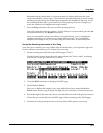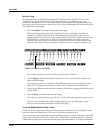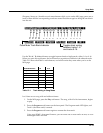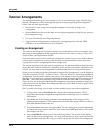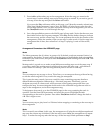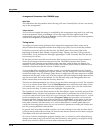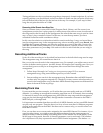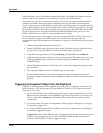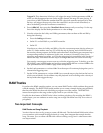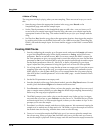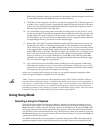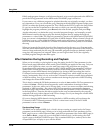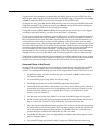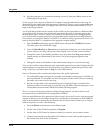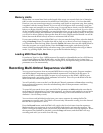
Song Mode
RAM Tracks
12-17
TriggerCtl: This determine if the keys will trigger the steps. Set this parameter to ON, so
when you hit the appropriate note on the trigger channel, the step will start playing. If
you set it to a MIDI Controller number that has a physical controller assigned to it, then
the keys will trigger the step only when the controller is on (for switch controllers) or
above its halfway point (for continuous controllers).
4. Press ARRANG, then press the Chan/Bank Down button until you see Step 1 in the top
line of the display. Set the Mode parameter to a value of Stop.
5. Note the values for the LoKey and HiKey parameters, then set them to E 1 and E 2 by
doing the following:
• Press the SetRng soft button
• Strike E 1 on the K2661 or your MIDI controller
• Strike E 2
Note the new values for LoKey and HiKey. Now the current step starts playing when you
strike E 1. Strike another note (say E 2) while the step is playing, and on the first beat of
the next bar, the step repeats, and all the tracks that aren’t drum tracks get transposed up a
corresponding number of semitones (in this case, an octave). Generally, when you’re
triggering steps using keystrikes, you’ll hit the triggering key somewhere in the last bar of
the current step. This causes the new step to start right after the end of the current step.
You can also cause steps to start as soon as you hit the triggering note. To do this, go to the
TRANSMIT page in MIDI mode, and assign a control setup that has a value of Off for the
Sync parameter on the COMMON page of the Setup Editor.
6. Set the Latch parameter to a value of On. Now the steps will continue playing after you’ve
released the triggering note.
7. Set the VelTrk parameter to a value of Off if you want the step to play back at the level at
which you recorded it. Set it to On to vary the playback level according to the velocity of
the keystrikes that trigger the step.
RAM Tracks
If you have the K2661 sampling option, you can create RAM Tracks, which combines Song mode
with the sampler. The RAM Tracks feature enables you to create a sample during song playback,
then have the K2661 do the work of building a program out of the sample. The K2661 also
inserts the sample into the song so that it plays back in sync with the song.
Possibly the best feature of RAM Tracks is how it affects polyphony. By sampling the K2661’s
audio output, you can condense an entire song into a single track that uses only two voices of
polyphony.
Two Important Concepts
RAM Tracks and Song Playback
You don’t have to be recording a song to create a RAM track. The idea behind RAM tracks is that
you can make a quick sample during playback of a song, then integrate that sample into the
song. Of course, you can create a RAM track while recording a song, but it’s often best to take
one step at a time.



